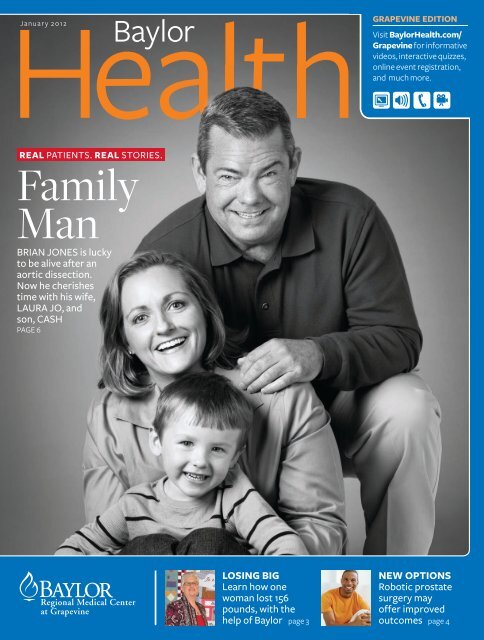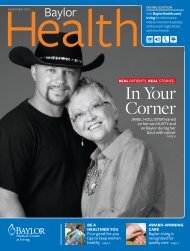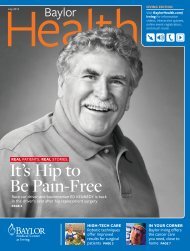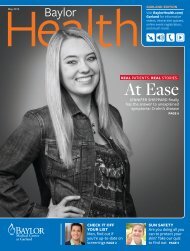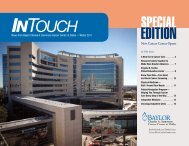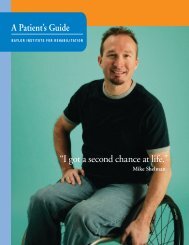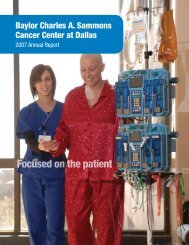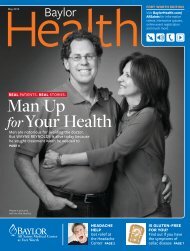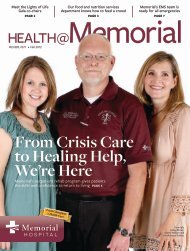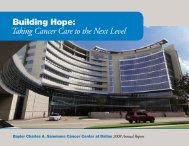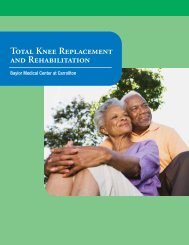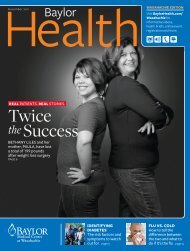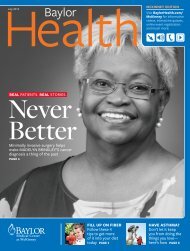Grapevine - Baylor Health Care System Online Newsroom
Grapevine - Baylor Health Care System Online Newsroom
Grapevine - Baylor Health Care System Online Newsroom
Create successful ePaper yourself
Turn your PDF publications into a flip-book with our unique Google optimized e-Paper software.
<strong>Health</strong><br />
<strong>Baylor</strong><br />
<strong>Health</strong><br />
GRAPEVINE<br />
January 2012<br />
EDITION<br />
Visit <strong>Baylor</strong><strong>Health</strong>.com/<br />
<strong>Grapevine</strong> for informative<br />
videos, interactive quizzes,<br />
online event registration,<br />
and much more.<br />
REAL PATIENTS. REAL STORIES.<br />
Family<br />
Man<br />
BRIAN JONES is lucky<br />
to be alive after an<br />
aortic dissection.<br />
Now he cherishes<br />
time with his wife,<br />
LAURA JO, and<br />
son, CASH<br />
PAGE 6<br />
LOSING BIG<br />
Learn how one<br />
woman lost 156<br />
pounds, with the<br />
help of <strong>Baylor</strong> page 3<br />
NEW OPTIONS<br />
Robotic prostate<br />
surgery may<br />
offer improved<br />
outcomes page 4
Exercise, Therapy<br />
or Surgery<br />
Has an injury sidelined you<br />
Take our quiz to find the right course<br />
of action<br />
When it comes to making a full recovery, getting<br />
the right treatment at the right time is key.<br />
Whatever your injury, this quiz will help you decide<br />
what your next step should be.<br />
1 How long ago did the injury occur<br />
a. Just recently, and it was the first injury I’ve had like it.<br />
b. Recently, but it’s a recurring one.<br />
c. A few months ago, but I still have pain or difficulty.<br />
2 How severe is or was your injury<br />
a. Some light bruising (or none at all) and mild pain.<br />
b. Bruising, swelling or pain that subsided in six weeks<br />
or less.<br />
c. Severe discoloration (blue-gray extremities),<br />
severe bruising, swelling and pain lasting several<br />
weeks or more.<br />
3 What impact has the injury had on your life<br />
a. Not much; it’s getting better with RICE (rest, ice,<br />
compression and elevation).<br />
b. It’s frustrating and it’s getting in the way of doing the<br />
things I love.<br />
c. I regularly modify my activities around my injury.<br />
YOuR RESuLTS<br />
Mostly A’s: Exercise<br />
After the initial bruising, swelling and pain subside, Eric<br />
Stehly, M.D., an orthopedic surgeon on the medical staff at<br />
<strong>Baylor</strong> Regional Medical Center at <strong>Grapevine</strong>, recommends<br />
slowly and cautiously returning to light exercise as you feel<br />
comfortable, and calling your doctor if something doesn’t<br />
feel right.<br />
Mostly B’s: Therapy<br />
Repeat injuries usually indicate that a prior injury wasn’t<br />
treated properly the first time. Physical therapy is likely your<br />
best bet for making a full recovery. “There’s also a chance<br />
that a combination of surgery and physical therapy may be<br />
the right course of action,” Dr. Stehly says.<br />
Mostly C’s: Surgery<br />
“Injuries this severe and slow-to-heal are usually the result<br />
of broken bones, torn ligaments or prior injuries that<br />
should have received more aggressive treatment in the<br />
past,” Dr. Stehly says. “An orthopedist can help figure out<br />
what’s really going on in there and determine the next steps<br />
for therapy, surgery and beyond.” l By Alissa Edwards<br />
FIND A DOCTOR<br />
Get It Checked<br />
Still unsure of the next steps for healing your injury The<br />
orthopedic experts at <strong>Baylor</strong> Regional Medical Center at<br />
<strong>Grapevine</strong> can help. To find a physician, call 1.800.4BAYLOR<br />
or visit FindDrRight.com.<br />
<strong>Baylor</strong> Regional Medical Center at<br />
<strong>Grapevine</strong><br />
1650 W. College, <strong>Grapevine</strong>, TX 76051<br />
Director of Marketing: Dee Dee Ogrin<br />
Senior Marketing/PR Consultant:<br />
LaKisha Miller<br />
Community Relations Consultant:<br />
Rachel Nobles<br />
Cardiovascular Marketing Consultant:<br />
Elizabeth Ables<br />
Sports<strong>Care</strong> Representative: Adam Brooks<br />
<strong>Baylor</strong> <strong>Grapevine</strong> Main Number:<br />
817.481.1588<br />
<strong>Baylor</strong> <strong>Grapevine</strong> Physician Referral:<br />
1.800.4BAYLOR (1.800.422.9567)<br />
Educational Programs: 817.329.2878<br />
<strong>Baylor</strong> <strong>Grapevine</strong> Diagnostic Imaging<br />
Center: 817.305.5010<br />
<strong>Baylor</strong> Diagnostic Imaging Center at<br />
Keller: 817.482.2000<br />
<strong>Baylor</strong> <strong>Grapevine</strong> Women’s Center:<br />
817.424.4500<br />
24-Hour Emergency: 817.329.2523<br />
<strong>Baylor</strong> Therapy Center: 817.329.2524<br />
Clinical Nutrition Programs: 817.329.2569<br />
<strong>Baylor</strong> <strong>Grapevine</strong> Volunteer Services/<br />
Auxiliary: 817.329.2665<br />
<strong>Baylor</strong> <strong>Health</strong> <strong>Care</strong> <strong>System</strong> Mission:<br />
Founded as a Christian ministry of healing,<br />
<strong>Baylor</strong> <strong>Health</strong> <strong>Care</strong> <strong>System</strong> exists to serve<br />
all people through exemplary health care,<br />
education, research and community service.<br />
Visit <strong>Baylor</strong><strong>Health</strong>.com or call<br />
1.800.4BAYLOR for information about<br />
<strong>Baylor</strong> Regional Medical Center at<br />
<strong>Grapevine</strong> services, upcoming events,<br />
physician referrals, career opportunities<br />
and more.<br />
<strong>Baylor</strong><strong>Health</strong> is published six times a year by<br />
McMurry. © 2012 <strong>Baylor</strong> <strong>Health</strong> <strong>Care</strong> <strong>System</strong>.<br />
The material in <strong>Baylor</strong><strong>Health</strong> is not intended<br />
for diagnosing or prescribing. Consult your<br />
physician before under taking any form of<br />
medical treatment or adopting any exercise<br />
program or dietary guidelines.<br />
Physicians are members of the medical staff at<br />
one of <strong>Baylor</strong> <strong>Health</strong> <strong>Care</strong> <strong>System</strong>’s subsidiary,<br />
community or affiliated medical centers and<br />
are neither employees nor agents of those<br />
med ical centers, <strong>Baylor</strong> Regional Medical<br />
Center at <strong>Grapevine</strong> or <strong>Baylor</strong> <strong>Health</strong> <strong>Care</strong><br />
<strong>System</strong>. Some physicians are employees of<br />
<strong>Health</strong> Texas Provider Network. <strong>Baylor</strong> Medical<br />
Plaza at Keller is not a legal entity but a location<br />
for the provision of health care services.<br />
Photographs may include models or actors<br />
and may not represent actual patients.<br />
If you are receiving multiple copies, need<br />
to change your mailing address or do not<br />
wish to receive this publication, please<br />
send your mailing label(s) and the updated<br />
information to Robin Vogel, <strong>Baylor</strong> <strong>Health</strong> <strong>Care</strong><br />
<strong>System</strong>, 2001 Bryan St., Suite 750, Marketing<br />
Department, Dallas, TX 75201, or email the<br />
information to robinv@baylorhealth.edu.<br />
2 <strong>Baylor</strong><strong>Health</strong> January 2012 l <strong>Baylor</strong><strong>Health</strong>.com/<strong>Grapevine</strong> Cover portrait by John Derryberry
When Dieting<br />
Isn’t Enough<br />
Weight loss surgery helps local woman lose 156 pounds<br />
In June 2009, Beverly Eden boarded<br />
a flight for an Alaska vacation and<br />
discovered she couldn’t buckle the<br />
seat belt. “I sat there and cried,” she<br />
says. “When I told my husband, he said<br />
to just get one of those extensions, but<br />
I said, ‘I’m not doing it.’ ” Eden covered<br />
her lap with her coat and flew without<br />
buckling in. But she was determined to<br />
do something about her weight.<br />
This wasn’t the first time the Rhome<br />
resident battled obesity. “I have lost<br />
100 pounds three different times in my<br />
adult life,” she says. But each time she<br />
gained the weight back, plus more. “I had<br />
pretty much given up on everything,”<br />
Eden says.<br />
After she returned home from Alaska<br />
she met a friend who had lost 75 pounds<br />
after weight loss surgery. Inspired, Eden<br />
started the process toward her own<br />
surgery the next day.<br />
and sleep apnea. She has eliminated<br />
or greatly reduced the treatments she<br />
needs to control these conditions, most<br />
of which have disappeared altogether.<br />
Before<br />
Beverly Eden, before having weight loss surgery.<br />
After<br />
Exceeding Expectations<br />
In January 2010, before her surgery at<br />
<strong>Baylor</strong>, she weighed 300 pounds. Her<br />
goal was to lose 100 pounds before her<br />
50th birthday, and she reached it with<br />
two weeks to spare. Eden has lost a<br />
total of 156 pounds and now, at 144<br />
pounds, is 10 pounds lighter than her<br />
doctor predicted.<br />
Eden, a middle school office<br />
manager, had a host of other medical<br />
problems either caused or exacerbated<br />
by her obesity: high blood pressure,<br />
high cholesterol, restless leg syndrome,<br />
insomnia, fibromyalgia, acid reflux<br />
Today, Eden is 156 pounds lighter and enjoying an active lifestyle.<br />
A Change in Lifestyle<br />
She points out that surgery is a tool, not<br />
a magic bullet. “Surgery allows you to eat<br />
much smaller portions and feel full,” she<br />
LEARN MORE<br />
Find Out If You Are a Candidate<br />
for Weight Loss Surgery<br />
The <strong>Baylor</strong> Weight Loss Surgery Center offers a comprehensive<br />
program, including three different surgical options that can help<br />
you reach your weight loss goals. To register for the FREE online<br />
weight loss seminar, visit YourWeightLossSurgerySeminar.com.<br />
says. She has learned to think about what<br />
she’s putting into her body and to make<br />
healthier choices.<br />
She also has changed her activity level<br />
from “nonexistent” to “very active.” She<br />
works out three to five times a week and<br />
also likes to walk, cycle and swim. With<br />
the extra pounds out of the way, she can<br />
keep up with her 10 grandchildren.<br />
And those airplane seat belts<br />
She flew home from New Orleans<br />
recently. “I had about 15 inches of<br />
seat belt left over!” she says. l<br />
By Deborah Paddison<br />
<strong>Baylor</strong><strong>Health</strong>.com/<strong>Grapevine</strong> l January 2012 <strong>Baylor</strong><strong>Health</strong> 3
Zooming In on<br />
Prostate Surgery<br />
Robotic surgical procedures typically bring better outcomes<br />
For men who have prostate cancer, surgery is sometimes<br />
the best treatment option. But traditional open surgery<br />
can sometimes lead to complications including lack of<br />
urinary control and decreased sexual function.<br />
A new robotic technique may improve outcomes and reduce<br />
side effects. Bryan Bruner, M.D., a urologist on the medical staff<br />
at <strong>Baylor</strong> Regional Medical Center at <strong>Grapevine</strong>, explains that<br />
with robotic surgery, doctors inflate the abdomen with a gas and<br />
insert small instruments on robotic arms.<br />
One of the instruments is a camera that magnifies the view<br />
10 times. The image is displayed on a nearby console in high<br />
definition and 3-D. The surgeon controls the instruments with<br />
a joystick at the console, which allows for precise movements<br />
even at 10 times magnification. “It’s almost like being in the<br />
body of the patient,” Dr. Bruner says.<br />
Check out the chart below for side-by-side comparisons of<br />
traditional and robotic surgery. l By Deborah Paddison<br />
EXPLORE YOUR OPTIONS<br />
Learn More About<br />
Prostate Cancer <strong>Care</strong><br />
To learn more about treatment options for prostate cancer or for<br />
a referral to a urologist on the medical staff at <strong>Baylor</strong> <strong>Grapevine</strong>,<br />
call 1.800.4BAYLOR or visit <strong>Baylor</strong><strong>Health</strong>.com/<strong>Grapevine</strong>.<br />
Blood Loss<br />
TRAdITIONAL OPEN SURGERY<br />
Typically, men lose more than a quart of blood,<br />
often requiring transfusions.<br />
ROBOTIC SURGERY<br />
Because of the gas pressure in the abdomen, men<br />
typically lose less than 7 ounces of blood and are less<br />
likely to need transfusions.<br />
Hospital Stay Generally three to four days. One night for 90 percent of men.<br />
Catheter Men often need a catheter for three weeks. Men generally have a catheter from four to 10 days.<br />
Recovery Time<br />
Incisions<br />
Cancer Control<br />
Urinary Control and<br />
Sexual Function<br />
Most people are back to normal daily activities in<br />
four to six weeks.<br />
Surgeons open the lower abdomen with an<br />
8- to 10-inch incision.<br />
Studies have found success rates of 90 percent<br />
or higher.<br />
Most men have some degree of incontinence<br />
and loss of sexual function after prostate<br />
surgery. These side effects vary depending on<br />
age, cancer involvement and other factors.<br />
Most people are back to normal daily activities in one<br />
to two weeks.<br />
Surgeons insert the instruments through several<br />
incisions of about a half-inch or less.<br />
Growing data indicate that the magnification could<br />
potentially provide even better success rates.<br />
With the robot, the magnified vision and more<br />
precise movements increase the chance of better<br />
erectile function and better urinary continence.<br />
Source: Bryan Bruner, M.D., a urologist on the medical staff at <strong>Baylor</strong> Regional Medical Center at <strong>Grapevine</strong><br />
4 <strong>Baylor</strong><strong>Health</strong> January 2012 l <strong>Baylor</strong><strong>Health</strong>.com/<strong>Grapevine</strong>
Solving the Mysteries<br />
of Multiple Myeloma<br />
To find answers, investigators at the <strong>Baylor</strong> Sammons Cancer Center<br />
are studying myeloma at the cellular and molecular level<br />
Multiple myeloma is a malignant plasma cell<br />
disorder that accounts for approximately<br />
20,000, or 1.4 percent of, new cancer cases<br />
in the United States as well as about 11,000 deaths<br />
per year. Myeloma currently is considered an incurable<br />
blood cancer; however, new treatment has<br />
resulted in significant improvements in the quality<br />
of life of patients with myeloma and overall survival.<br />
Clinical investigators and research scientists at<br />
<strong>Baylor</strong> and other institutions are hoping to improve<br />
the treatment outcome.<br />
The <strong>Baylor</strong> Charles A. Sammons Cancer Center<br />
is one of 16 sites participating in a study led by<br />
the Multiple Myeloma Research Consortium.<br />
This research trial, which will enroll at least 1,000<br />
patients diagnosed with multiple myeloma, hopes<br />
to better understand the disease by studying how<br />
a patient’s individual molecular profile may affect<br />
the disease’s progression and his or her response<br />
to treatment.<br />
“We’re hoping to learn about changes that happen<br />
at the molecular level,” says Tracy Messing, R.N.,<br />
OCN, CCRC, research manager for the Office of<br />
Clinical Oncology Research Coordination at the<br />
<strong>Baylor</strong> Sammons Cancer Center. “If we can identify<br />
personalized molecular targets within each patient,<br />
the hope is that we could better tailor treatments<br />
for each individual.”<br />
Treatment Challenges—and Explorations<br />
According to Messing, the current challenge with<br />
the treatment of multiple myeloma is that even the<br />
best therapies have a short duration, after which the<br />
cancer recurs. One of the goals<br />
of the study is to develop new<br />
drugs based on the findings.<br />
Throughout the study, participants<br />
will provide bone marrow<br />
samples, which they would do as<br />
part of any treatment protocol.<br />
Patients will be treated using<br />
the existing therapy their doctor<br />
determines is most appropriate<br />
for their case. Participants will<br />
be tracked by researchers from<br />
initial diagnosis through the<br />
duration of their treatment, for<br />
a minimum of five years. The<br />
study will evaluate each patient’s response to his or<br />
her treatment and the course the disease takes.<br />
“How multiple myeloma progresses and<br />
responds to treatment at the molecular level is a<br />
very important scientific question,” says Joseph<br />
W. Fay, M.D., the principal investigator at <strong>Baylor</strong><br />
and director of immunotherapy for cancer at<br />
<strong>Baylor</strong> Research Institute. “This study is significant<br />
because it has the potential not only to impact the<br />
way we treat multiple myeloma, but may also serve<br />
as a model for the study and treatment of other<br />
cancers.” l By Amy Lynn Smith<br />
ReSeaRch<br />
Do You<br />
have Multiple<br />
Myeloma<br />
Most participants will be<br />
referred to the study by their<br />
physician. For more information,<br />
call 214.818.8472 or email<br />
cancer.trials@baylorhealth.edu.<br />
Illustration by Eva Tatcheva <strong>Baylor</strong><strong>Health</strong>.com l January 2012 <strong>Baylor</strong><strong>Health</strong> 5
Magnificent<br />
Bystander<br />
By Alissa Edwards<br />
Acting fast in the event of a cardiac<br />
or stroke emergency could save a life<br />
When Laura Jo Jones received a magnet in the mail from<br />
<strong>Baylor</strong> Regional Medical Center at <strong>Grapevine</strong> that listed<br />
heart attack symptoms, she didn’t think much of it. In<br />
fact, she almost threw it away.<br />
But when her husband, 44-year-old Brian Jones, experienced<br />
severe chest pain as they were getting ready for bed one night,<br />
she was glad she had kept it. “My wife grabbed the magnet and<br />
started reading off the symptoms—and I had most of them,” he<br />
says. “That’s when she knew without a doubt to call 911.”<br />
While it wasn’t a heart attack, it was a life-threatening tear in<br />
a major artery. “An aortic dissection sometimes presents like a<br />
heart attack, but classically the first symptom is a severe, tearing<br />
pain in the chest that radiates to the back,” says Manish<br />
Assar, M.D., a cardiologist on the medical staff at <strong>Baylor</strong><br />
University Medical Center at Dallas. “The key to survival in<br />
either case is receiving immediate medical attention.”<br />
Brian underwent a triple bypass, valve repair and pacemaker<br />
placement. “From the time I arrived at the <strong>Baylor</strong><br />
<strong>Grapevine</strong> ER to surgery, it was less than three hours,”<br />
Brian says. He’s lucky he survived—and Laura Jo is part of<br />
the reason he did. “Most people don’t survive an aortic<br />
dissection,” Dr. Assar says. In<br />
Brian Jones is lucky to<br />
be alive after an aortic<br />
dissection. His wife,<br />
Laura Jo, recognized<br />
symptoms and called 911.<br />
other words, if his wife hadn’t<br />
recognized his symptoms and<br />
acted immediately, he probably<br />
wouldn’t be here today.<br />
WATCH THE VIDEO<br />
See Brian’s Story<br />
To hear more about Brian Jones’ story, watch his video<br />
at <strong>Baylor</strong><strong>Health</strong>.com/<strong>Health</strong>cast today.
The Push She Needed<br />
When Janie Morris, 70, began experiencing vision trouble<br />
while reading the paper one afternoon, her first thought was<br />
that she should call the eye doctor. But as the minutes<br />
wore on, it became clear that something was very<br />
wrong. “I told my husband I couldn’t see my hand<br />
spreading cheese on my cracker or the columns in<br />
the paper, and I wasn’t speaking clearly,” Morris<br />
says. “He made me take two aspirin and insisted<br />
we go to the hospital right away.”<br />
When they arrived at <strong>Baylor</strong> Medical<br />
Center at Garland, her husband<br />
wasted no time. “He looked the<br />
attendant in the eye and said, ‘I<br />
believe my wife is having a stroke<br />
and we need attention right<br />
away,’ ” Morris says.<br />
He was right. Within minutes,<br />
she was undergoing a CT scan and<br />
receiving appropriate treatment.<br />
Be a Hero<br />
You never know when you’ll<br />
have the opportunity to recognize<br />
the signs of a cardiac or<br />
stroke emergency. Here’s how you<br />
can be prepared:<br />
Brush up on your knowledge.<br />
As a rule, everyone should be familiar<br />
with the signs of stroke and heart attack.<br />
“Take the time to memorize the symptoms<br />
before you’re in a heart or stroke<br />
Jerry Morris saved his wife Janie’s life when he<br />
recognized signs of a stroke and called 911.<br />
DOWNLOAD<br />
Get Your Guide<br />
to Heart and Stroke<br />
Emergencies<br />
To save a life, you have to know the symptoms<br />
of heart attack and stroke. Download a tip<br />
sheet at <strong>Baylor</strong><strong>Health</strong>.com/<strong>Health</strong>cast/<br />
HeartAndStroke today.<br />
emergency, and, of course, taking a CPR and<br />
first-aid class is a great way to be prepared<br />
for any emergency,” Dr. Assar says.<br />
Carry aspirin. “If someone is experiencing<br />
symptoms that could be related<br />
to a stroke or heart attack, have them<br />
chew two aspirin unless there’s an<br />
allergy,” says Richard Feingold, D.O.,<br />
a cardiologist on the medical staff at<br />
<strong>Baylor</strong> <strong>Grapevine</strong>.<br />
Always have your cell phone.<br />
“You’ll never regret calling 911 if it<br />
turns out to be nothing,” Dr. Feingold<br />
says. “And if it’s something, you<br />
could save their life.”<br />
Speak up. If you think someone<br />
may be experiencing a stroke or<br />
cardiac emergency, insist that<br />
he or she get help immediately.<br />
“Especially in the case of a stroke, a<br />
person may not be thinking clearly<br />
enough to make the right decision,”<br />
Dr. Feingold says. “If they have a<br />
list of medications they are currently<br />
taking nearby, be sure to bring that to<br />
the hospital as well.” ●<br />
Saving Time, Saving Hearts<br />
When a heart attack strikes, treatment<br />
speed is crucial in saving both heart<br />
muscle and a life. David Scherer, M.D.,<br />
medical director of interventional<br />
cardiology at <strong>Baylor</strong> Regional Medical<br />
Center at <strong>Grapevine</strong>, says just 3 percent of<br />
heart attacks are fatal if treatment starts<br />
within 30 minutes. That figure jumps to<br />
6 percent after 90 minutes, and increases<br />
exponentially after that.<br />
Established by the American College<br />
of Cardiology, the national standard for<br />
door-to-balloon times is 90 minutes.<br />
<strong>Baylor</strong> <strong>Grapevine</strong> is currently averaging<br />
54 to 56 minutes—significantly lower<br />
than national guidelines.<br />
Door-to-balloon times refer to the time<br />
from when a patient enters the emergency<br />
room to the time the patient receives a<br />
lifesaving procedure. This length of time<br />
is critical when a patient is having a heart<br />
attack because “time is muscle.” The less<br />
time it takes to restore blood flow, the less<br />
damage is sustained by the heart muscle.<br />
<strong>Baylor</strong> Regional Medical Center at<br />
<strong>Grapevine</strong> treats heart attacks anytime,<br />
day or night. If you believe someone is<br />
suffering a heart attack, call 911.<br />
GET HEART SMART<br />
Are You at<br />
Risk for a Heart<br />
Attack<br />
Learn more about risk factors and steps<br />
you can take to prevent heart disease at<br />
<strong>Baylor</strong><strong>Health</strong>.com/<strong>Grapevine</strong>Heart.<br />
<strong>Baylor</strong><strong>Health</strong>.com/<strong>Grapevine</strong> ● January 2012 <strong>Baylor</strong><strong>Health</strong> 7
<strong>Baylor</strong> <strong>Health</strong> <strong>Care</strong> <strong>System</strong><br />
2001 Bryan Street, Suite 750<br />
Marketing Department<br />
Dallas, TX 75201<br />
Free. <strong>Online</strong>.<br />
All the time.<br />
At <strong>Baylor</strong><strong>Health</strong>.com/Exclusive you’ll find<br />
health information for you and your family<br />
you can’t get anywhere else, including:<br />
Articles l Videos l Recipes l Quizzes l Tips<br />
NON-PROFIT ORG.<br />
US POSTAGE<br />
PAID<br />
BAYLOR HEALTH<br />
Community Calendar<br />
January and February 2012<br />
january 2012<br />
What: Weight Loss Surgery Treatment Options<br />
When: Thursday, Jan. 19; 6 p.m.<br />
Where: Blue Mesa Grill<br />
1586 E. Southlake Blvd., Southlake<br />
What: Questions to Ask Your OB/GYN<br />
When: Thursday, Jan. 26; 6 p.m.<br />
Where: Blue Mesa Grill<br />
1586 E. Southlake Blvd., Southlake<br />
february 2012<br />
What: Knee Replacement: Know Your Options<br />
When: Thursday, Feb. 9; 6:30–8 p.m.<br />
Where: Conference Rooms A and B<br />
<strong>Baylor</strong> Regional Medical Center at <strong>Grapevine</strong><br />
1650 W. College St., <strong>Grapevine</strong><br />
What: Women’s Heart <strong>Health</strong>—<strong>Health</strong>y Eating & Cooking<br />
Demonstration<br />
When: Tuesday, Feb. 14; noon–1 p.m.<br />
Where: Center for Continuing Education<br />
<strong>Baylor</strong> Regional Medical Center at <strong>Grapevine</strong><br />
1650 W. College St., <strong>Grapevine</strong><br />
FIND A CLASS<br />
Make Time for<br />
Your <strong>Health</strong><br />
For more information about the classes and events offered at<br />
<strong>Baylor</strong> <strong>Grapevine</strong>, visit <strong>Baylor</strong><strong>Health</strong>.com/<strong>Grapevine</strong>/Events.<br />
JAN.<br />
28<br />
FOCUS ON YOU.<br />
SATURDAY, JANUARY 28, 2012<br />
7:00 A.M.-11:00 A.M.<br />
Take care of your health at our FREE annual<br />
women’s health event, For Women For Life . Enjoy<br />
breakfast and complimentary hand massages,<br />
receive free health screenings, learn about disease<br />
prevention and ask health questions to a panel of<br />
physicians. See you there!<br />
Download a code reader on<br />
your smartphone and scan this<br />
QR code to get event details.<br />
RSVP by calling 1.800.4BAYLOR<br />
Learn more at<br />
<strong>Baylor</strong><strong>Health</strong>.com/<strong>Grapevine</strong>ForWomen<br />
Physicians are members of the medical staff at one of <strong>Baylor</strong> <strong>Health</strong> <strong>Care</strong> <strong>System</strong>’s subsidiary, community or affi liated medical centers and are neither<br />
employees nor agents of those medical centers, <strong>Baylor</strong> Regional Medical Center at <strong>Grapevine</strong> or <strong>Baylor</strong> <strong>Health</strong> <strong>Care</strong> <strong>System</strong>. ©2011 <strong>Baylor</strong> <strong>Health</strong> <strong>Care</strong><br />
<strong>System</strong> BRMCGV_659 CE 11.11


